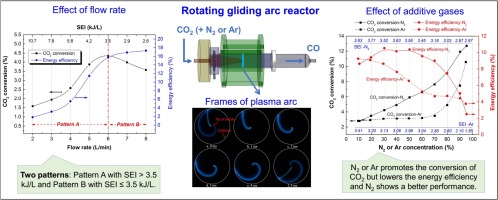Journal of CO2 Utilization ( IF 7.2 ) Pub Date : 2018-09-05 , DOI: 10.1016/j.jcou.2018.08.020 Hao Zhang , Li Li , Xiaodong Li , Weizong Wang , Jianhua Yan , Xin Tu

|
In this study, a rotating gliding arc (RGA) warm plasma has been developed for the conversion of CO2 into CO and O2. The effect of feed flow rate, applied voltage, arc current, and the addition of N2 or Ar on the reaction performance has been investigated. The results show two variation patterns of CO2 conversion and energy efficiency, depending on the specific energy input (SEI): In Pattern A with SEI > 3.5 kJ/L, the CO2 conversion and energy efficiency decrease simultaneously with increasing SEI, while in Pattern B with SEI ≤ 3.5 kJ/L, the energy efficiency and the CO2 conversion show an opposite trend. The recombination of CO and O at high temperatures could be responsible for the decrease of CO2 conversion with rising SEI due to the increased retention time or gas temperature. A CO2 conversion of 4.0-4.4% and energy efficiency of 16-17% can be achieved. Compared to other non-thermal plasmas, the RGA plasma exhibits a lower CO2 conversion but higher energy efficiency, whilst maintaining a flow rate (e.g, 6-7 L/min) that is significantly higher than that of typical non-thermal plasmas (e.g., 20-125 ml/min in dielectric barrier and corona discharges). Increasing the fraction of N2 or Ar promotes the conversion of CO2 but lowers the energy efficiency. N2 is clearly more beneficial for enhancing the CO2 conversion in comparison to Ar. Further enhancement of the reaction performance can be expected by cooling the plasma area to lower the gas temperature, to limit the recombination of CO and O.
中文翻译:

旋转滑动电弧放电反应器中CO 2的热等离子体活化
在这项研究中,已开发出旋转滑弧(RGA)加热等离子体,用于将CO 2转换为CO和O 2。研究了进料流量,施加电压,电弧电流以及N 2或Ar的添加对反应性能的影响。结果表明,CO 2转化率和能效的两个变化模式取决于比能量输入(SEI):在SEI> 3.5 kJ / L的模式A中,CO 2转化率和能效随SEI的增加而降低,而在SEI升高时SEI≤3.5 kJ / L的模式B,能效和CO 2转换显示相反的趋势。由于保留时间或气体温度的增加,高温下CO和O的重组可能会导致SEI升高而导致CO 2转化率降低。可以实现4.0-4.4%的CO 2转化率和16-17%的能源效率。与其他非热等离子体相比,RGA等离子体表现出较低的CO 2转化率,但是却具有更高的能源效率,同时保持的流速(例如6-7 L / min)明显高于典型的非热等离子体(例如介电势垒和电晕放电为20-125 ml / min)。增加N 2或Ar的含量会促进CO 2的转化,但会降低能量效率。N 2与Ar相比,对于提高CO 2转化率显然更有利。通过冷却等离子体区域以降低气体温度,限制CO和O的重组,可以期望进一步提高反应性能。











































 京公网安备 11010802027423号
京公网安备 11010802027423号